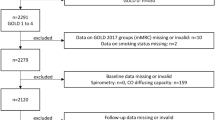Abstract
BACKGROUND
Smoking cessation has been demonstrated to reduce the rate of loss of lung function and mortality among patients with mild to moderate chronic obstructive pulmonary disease (COPD). There is a paucity of evidence about the effects of smoking cessation on the risk of COPD exacerbations.
OBJECTIVE
We sought to examine whether smoking status and the duration of abstinence from tobacco smoke is associated with a decreased risk of COPD exacerbations.
DESIGN
We assessed current smoking status and duration of smoking abstinence by self-report. Our primary outcome was either an inpatient or outpatient COPD exacerbation. We used Cox regression to estimate the risk of COPD exacerbation associated with smoking status and duration of smoking cessation.
PARTICIPANTS
We performed a cohort study of 23,971 veterans who were current and past smokers and had been seen in one of seven Department of Veterans Affairs (VA) primary care clinics throughout the US.
MEASUREMENTS AND MAIN RESULTS
In comparison to current smokers, ex-smokers had a significantly reduced risk of COPD exacerbation after adjusting for age, comorbidity, markers of COPD severity and socio-economic status (adjusted HR 0.78, 95% CI 0.75–0.87). The magnitude of the reduced risk was dependent on the duration of smoking abstinence (adjusted HR: quit <1 year, 1.04; 95% CI 0.87–1.26; 1–5 years 0.93, 95% CI 0.79–1.08; 5–10 years 0.84, 95% CI 0.70–1.00; ≥10 years 0.65, 95% CI 0.58–0.74; linear trend <0.001).
CONCLUSIONS
Smoking cessation is associated with a reduced risk of COPD exacerbations, and the described reduction is dependent upon the duration of abstinence.

Similar content being viewed by others
References
Data Fact Sheet: Chronic Obstructive Pulmonary Disease, National Heart Blood and Lung Institiute. NIH Publication Number 2003;30–5229.
Calverley PM. Reducing the frequency and severity of exacerbations of chronic obstructive pulmonary disease. Proc Am Thorac Soc. 2004;1:121–4.
Kanner RE, Connett JE, Williams DE, Buist AS. Effects of randomized assignment to a smoking cessation intervention and changes in smoking habits on respiratory symptoms in smokers with early chronic obstructive pulmonary disease: the Lung Health Study. Am J Med. 1999;106:410–6.
Bolliger CT, Zellweger JP, Danielsson T, et al. Influence of long-term smoking reduction on health risk markers and quality of life. Nicotine Tob Res. 2002;4:433–9.
Anthonisen NR, Skeans MA, Wise RA, Manfreda J, Kanner RE, Connett JE. The effects of a smoking cessation intervention on 14.5-year mortality: a randomized clinical trial. Ann Intern Med. 2005;142:233–9.
Faulkner MA, Lenz TL, Stading JA. Cost-effectiveness of smoking cessation and the implications for COPD. Int J Chron Obstruct Pulmon Dis. 2006;1:279–87.
Hoogendoorn M, Welsing P, Rutten-van Molken MP. Cost-effectiveness of varenicline compared with bupropion, NRT, and nortriptyline for smoking cessation in the Netherlands. Curr Med Res Opin. 2008;24:51–61.
Johansson PM, Tillgren PE, Guldbrandsson KA, Lindholm LA. A model for cost-effectiveness analyses of smoking cessation interventions applied to a Quit-and-Win contest for mothers of small children. Scand J Public Health. 2005;33:343–52.
Tsevat J. Impact and cost-effectiveness of smoking interventions. Am J Med. 1992;93:43S–7S.
Fan VS, Au D, Heagerty P, Deyo RA, McDonell MB, Fihn SD. Validation of case-mix measures derived from self-reports of diagnoses and health. J Clin Epidemiol. 2002;55:371–80.
The Health Consequences of Smoking: a Report of the Surgeon General. Washington DC: Department of Health and Human Services, Centers for Disease Control and Prevention. 2004;42–61.
Cigarette Smoking Among Adults-United States. 2003 doi:10.1001/jama.294.2.172. JAMA 2005;294:172–3.
Asaria P, Chisholm D, Mathers C, Ezzati M, Beaglehole R. Chronic disease prevention: health effects and financial costs of strategies to reduce salt intake and control tobacco use. Lancet. 2007;370:2044–53.
Ait-Khaled N, Enarson D, Bousquet J. Chronic respiratory diseases in developing countries: the burden and strategies for prevention and management. Bull World Health Organ. 2001;79:971–9.
Fagerstrom K. The epidemiology of smoking: health consequences and benefits of cessation. Drugs. 2002;62(Suppl 2):1–9.
Anthonisen NR, Connett JE, Kiley JP, et al. Effects of smoking intervention and the use of an inhaled anticholinergic bronchodilator on the rate of decline of FEV1. The Lung Health Study. Jama. 1994;272:1497–505.
Anthonisen NR. Long-term oxygen therapy. Ann Intern Med. 1983;99:519–27.
American Thoracic Society/European Respiratory Society Task Force. Standards for the Diagnosis and Management of Patients with COPD [Internet]. New York: American Thoracic Society.
Turato G, Zuin R, Miniati M, et al. Airway inflammation in severe chronic obstructive pulmonary disease: relationship with lung function and radiologic emphysema. Am J Respir Crit Care Med. 2002;166:105–10.
Saetta M, Di Stefano A, Turato G, et al. CD8+ T-lymphocytes in peripheral airways of smokers with chronic obstructive pulmonary disease. Am J Respir Crit Care Med. 1998;157:822–6.
Dahl M, Vestbo J, Lange P, Bojesen SE, Tybjaerg-Hansen A, Nordestgaard BG. C-reactive protein as a predictor of prognosis in chronic obstructive pulmonary disease. Am J Respir Crit Care Med. 2007;175:250–5.
Bhowmik A, Seemungal TA, Sapsford RJ, Wedzicha JA. Relation of sputum inflammatory markers to symptoms and lung function changes in COPD exacerbations. Thorax. 2000;55:114–20.
Donaldson GC, Seemungal TA, Patel IS, et al. Airway and systemic inflammation and decline in lung function in patients with COPD. Chest. 2005;128:1995–2004.
Mercer PF, Shute JK, Bhowmik A, Donaldson GC, Wedzicha JA, Warner JA. MMP-9, TIMP-1 and inflammatory cells in sputum from COPD patients during exacerbation. Respir Res. 2005;6:151.
Wilt TJ, Niewoehner D, MacDonald R, Kane RL. Management of stable chronic obstructive pulmonary disease: a systematic review for a clinical practice guideline. Ann Intern Med. 2007;147:639–53.
Hogg JC, Chu F, Utokaparch S, et al. The nature of small-airway obstruction in chronic obstructive pulmonary disease. N Engl J Med. 2004;350:2645–53.
Willemse BW, ten Hacken NH, Rutgers B, Lesman-Leegte IG, Postma DS, Timens W. Effect of 1-year smoking cessation on airway inflammation in COPD and asymptomatic smokers. Eur Respir J. 2005;26:835–45.
Cummings KM, Giovino G, Jaen CR, Emrich LJ. Reports of smoking withdrawal symptoms over a 21 day period of abstinence. Addict Behav. 1985;10:373–81.
Bluman LG, Mosca L, Newman N, Simon DG. Preoperative smoking habits and postoperative pulmonary complications. Chest. 1998;113:883–9.
Yamashita S, Yamaguchi H, Sakaguchi M, Yamamoto S, Aoki K, Shiga Y, Hisajima Y. Effect of smoking on intraoperative sputum and postoperative pulmonary complication in minor surgical patients. Respir Med. 2004;98:760–6.
Verra F, Escudier E, Lebargy F, Bernaudin JF, De Cremoux H, Bignon J. Ciliary abnormalities in bronchial epithelium of smokers, ex-smokers, and nonsmokers. Am J Respir Crit Care Med. 1995;151:630–4.
Niewoehner DE, Lokhnygina Y, Rice K, et al. Risk indexes for exacerbations and hospitalizations due to COPD. Chest. 2007;131:20–8.
Wilt TJ, Niewoehner D, Kane RL, MacDonald R, Joseph AM. Spirometry as a motivational tool to improve smoking cessation rates: a systematic review of the literature. Nicotine Tob Res. 2007;9:21–32.
Boyd NR, Windsor RA, Perkins LL, Lowe JB. Quality of measurement of smoking status by self-report and saliva cotinine among pregnant women. Matern Child Health J. 1998;2:77–83.
Etter JF, Stapleton JA. Nicotine replacement therapy for long-term smoking cessation: a meta-xanalysis. Tob Control. 2006;15:280–5.
Stxate Medicaid coverage for tobacco-dependence treatments-United States. 2005. MMWR Morb Mortal Wkly Rep. 2006;55:1194–7.
Curry SJ, Keller PA, Orleans CT, Fiore MC. The Role of Health Care Systems in Increased Tobacco Cessation. Annu Rev Public Health 2008.
Acknowledgments
David Au had full access to all of the data in the study and takes responsibility for the integrity of the data and the accuracy of the data analysis. This study was funded by the Department of Veterans Affairs: IAC 05–206 and IIR-99-376. Dr. Bryson is funded by a VA Career Development Award (RCS 03-177).
Conflict of Interest
None disclosed.
Author information
Authors and Affiliations
Corresponding author
Additional information
The views expressed in the manuscript reflect those of the authors and not necessarily those of the Department of Veterans Affairs.
Rights and permissions
About this article
Cite this article
Au, D.H., Bryson, C.L., Chien, J.W. et al. The Effects of Smoking Cessation on the Risk of Chronic Obstructive Pulmonary Disease Exacerbations. J GEN INTERN MED 24, 457–463 (2009). https://doi.org/10.1007/s11606-009-0907-y
Received:
Revised:
Accepted:
Published:
Issue Date:
DOI: https://doi.org/10.1007/s11606-009-0907-y




